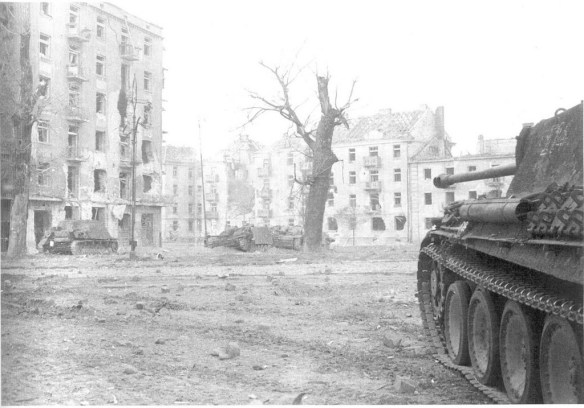The largest German armoured units in Poland’s capital city on August 1, 1944, were the 1st and 2nd companies from Panzer-Abseiling 743., stationed at Plac Saski and Plac Teatralny. Each these units consisted of fourteen armoured anti-tank guns, model Jagdpanzer 38(t) Hetzer – from here on out, to be called a Jagpanzer or Hetzer, as they are correctly referred to – and quite likely a few armoured vehicle assault guns, model Sturmgeschutz 40 Sd Kfz 142/1 Ausf., henceforth, referred to here simply as the StuG 40, within units of the 2nd company.
Within the so-called Police District, the head of the SS and its police army (SS und Polizeiführer) in Warsaw, SS-Standarten-führer, Paul Otto Geibel, had command over a tank platoon comprised of four to five Italian tanks, models M13/40 and M14/41, to be referred to in the future as the PzKpfw 736 (i).
In a “so called” Kraftfahrpark (motor pool repair facility) at Fort Bema in the district of Wola, there were several other armoured cars and armoured transportation vehicles which had been repaired. Cars and other vehicles were also repaired on a continuous basis at the Kraftfahrpark on Ulica Gniewkowska (Ulica: Street/ Avenue in English).
On August 1, the off-loading of tanks belonging to the II Fallschirm-Panzer-Regiment “Hermann Göring” commenced in Wola (Ulrychów) and Boernerowo. These were directed towards the front outside Siedlce, Minsk and Wolomin, as well as the front outside Magnuszew, east of Warsaw. On July 31, five model PzKpfw VI Tiger Ausf. E tanks were off-loaded, after having been repaired and sent from Germany, as reinforcement to the 3rd SS-Panzer-Division “Totenkopf ”. The Tigers were driven by factory personnel along the streets of Ulica 22 Listopada, Ulica Targowa, Ulica Zielieniecka, Ulica 3 Maja, Aleje Jerozolimske, Ulica Chaubinskiego, Aleje Niepodleglości (Ulica Topolowa) and Ulica Rakowiecka to the SS-Staufernkasern (SS-garrison) located on Ulica Rakowiecka 4. In addition, the garrison already had some tanks that had been repaired there. Von Krannhals, (Hans Von Krannhals, Der Warschauer Aufstand 1944, Frankfurt am Main 1964, p.242) reports that there were 11 vehicles at the SS-Staufernkasern: five Tiger tanks, a Panther tank-PzKpfw V, four PzKpfw IV tanks, and a self-propelled Sturmpanzer IV Brummbär asssault gun. All were repaired vehicles from other units, among them, the 3rd SS-Panzer-Division “Totenkopf ” as well as the 5th SS-Panzer-Division “Wiking”.
Mention should also be made of certain other armoured vehicles, for example, those with the SA’s headquarters in Ulica Krucza, and the anti-aircraft artillery’s tractors at Pole Mokotowskie and at the air field in Okęcie. In addition to these, account should be taken of the tanks moving east through Warsaw towards the front. For example, the PzKpfw IVs which were sent to reinforce the 3rd SS-Panzer-Regiment “Totenkopf” and then sent to an elementary school at Ulica Mieszka I in the city district of Targówek. These tanks could, at any time, be “recalled” to the city and sent in against the resistance fighters. In addition, the German commander could also direct frontline forces to Warsaw, but the situation at the front was such that this safeguard was not taken at the beginning.
Near the dinner-hour of August 1, a StuG 40 under the command of Lt. Jg Kannert from Fallschirm-Panzer-Division “Herman Göring” found itself in the city district of Praga. This vehicle, as it happened, had been sent to the FAMO-Warschaus factory in Ursus outside Warsaw for repairs. In the vicinity of Most Kierbedzia (the Kierbedzia Bridge), soldiers from an infantry unit informed Kannert that the Uprising had broken out. Kannert was transporting a wounded colleague, Lt. Jg Hoffman, and therefore decided to make his way through Warsaw. Despite taking hostile fire, Kannert rolled across the bridge towards the city’s centre along the Ulica Mowy Zjazd. Ulica Senatorska was cordoned off by a barricade and so he swung left and came to Plac Pilsudskiego (Pilsud’s Square), or “Adolf Hitler Platz” as the Germans named it, where the garrison’s regiment was quartered. The wounded Hoffman was taken to the hospital. At the garrison, the crew was also provided with additional equipment and ordered to fire upon on the insurgents’ positions. The gun-loader fired with a submachinegun while Kannert used “the artillery” – i.e. a Panzerfaust that had been assigned to him, and with which he demolished the Polish positions (Ulica Krakowskie Przedmieście). On August 2, a StuG 40 was dispatched to attack the Polish emplacements on Theatre Square. A shell exploded while being fired, which destroyed the main gun’s barrel. The crew, nevertheless, continued to fire on the Polish positions in the municipal building with a machinegun, which was the only weapon at hand. The following day the crew was ordered to retrieve a tank from the Kraftfahrpark in Praga. They got over the Kierbiedz Bridge and through Praga without difficulty. There, the crew came upon a PzKpfw II Ausf. F tank that, for some unknown reason, had been abandoned. A tow line was attached and the StuG 40 proceeded to tow the tank back the way they had come. While crossing the Wisła, these German armoured vehicles came under fire from insurgents shooting from Stare Miasto (The Old City). The PzKpfw II was carelessly driven and collided with its “recovery vehicle” which caused the tow line to break. After once again securing a tow line, the German armoured vehicles resumed their journey.
